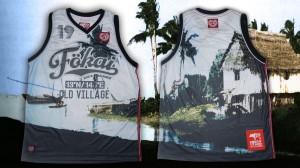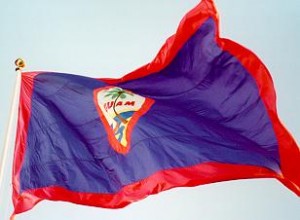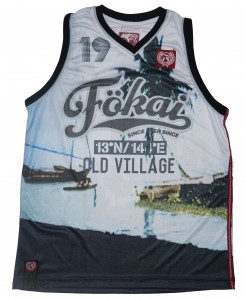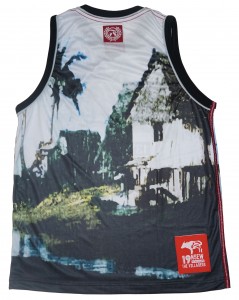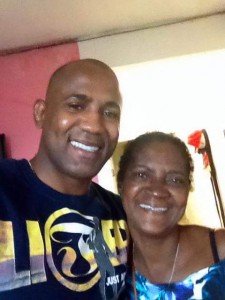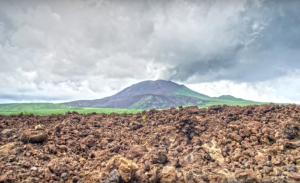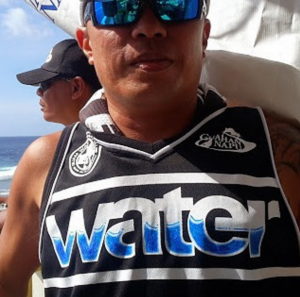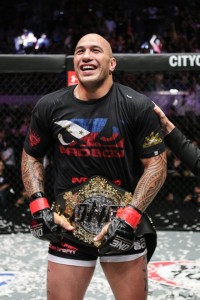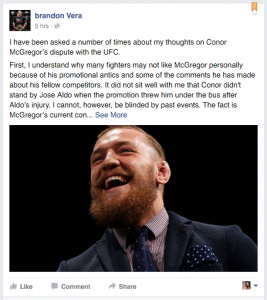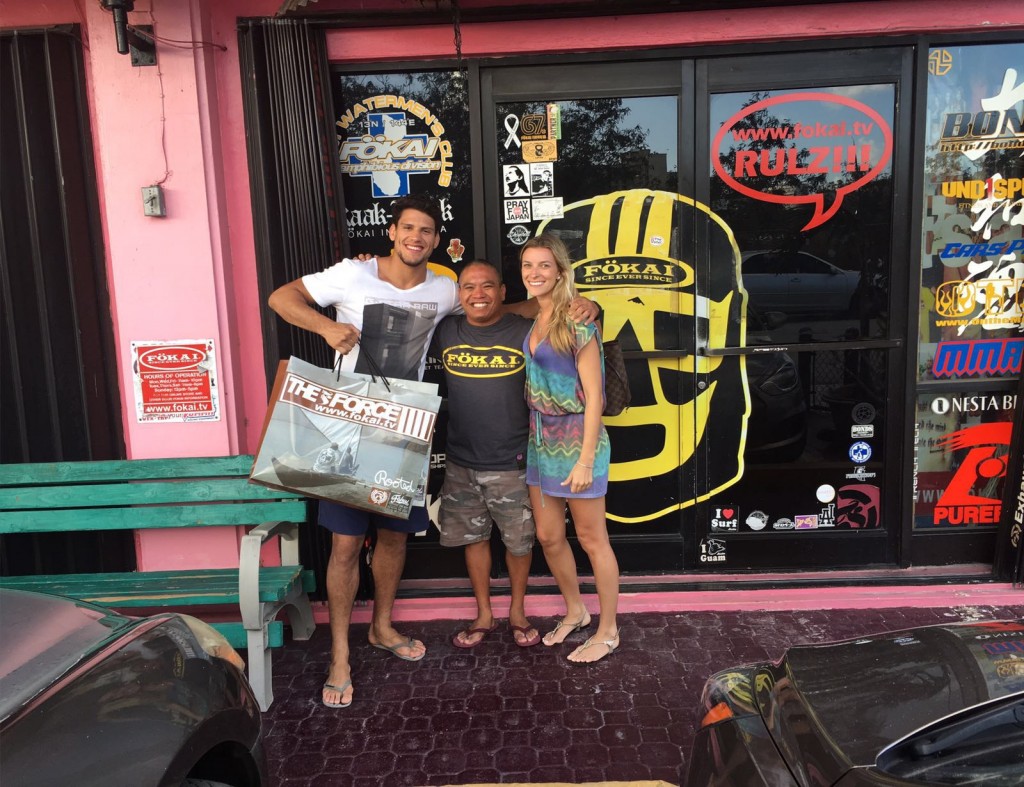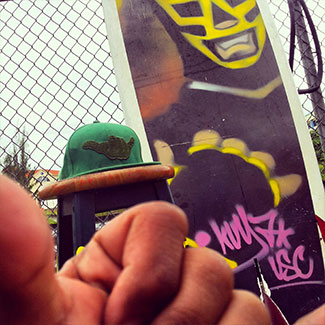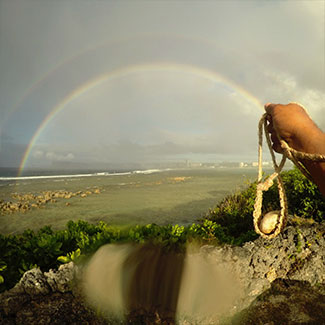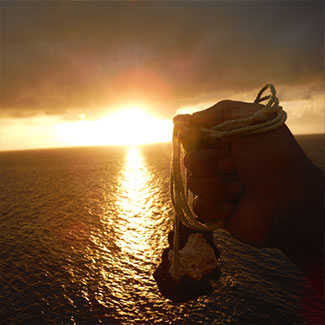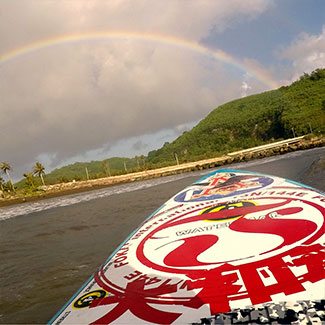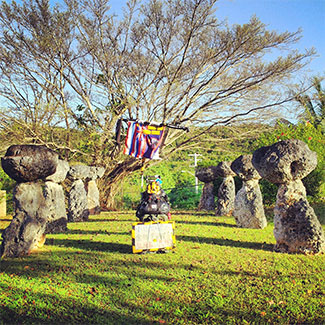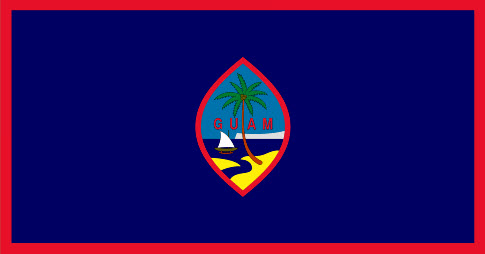ROOTS: Fokai OLD VILLAGE REAL FLAG TANK! Where the Guam Flag was designed.
May 11, 2016 by admin
Filed under Special Forces
ROOTS: Fokai OLD VILLAGE REAL FLAG TANK! Where the Guam Flag was designed.
Get your Fokai OLD VILLAGE REAL FLAG TANK here!
The Great Seal of Guam by: ns.gov.gu
The blueprint shows a tree and proa (canoe) in front of a silhouette of Urunao (It is not Two Lover’s Point, see below) and specifies the flag’s colors. There are several possible inspirations of the flag’s design, including a photograph from Gov. Robert E. Coontz’s collection from 1912, and the works of local artist Francisco Feja and Helen Paul, the wife of a U.S. Navy officer.
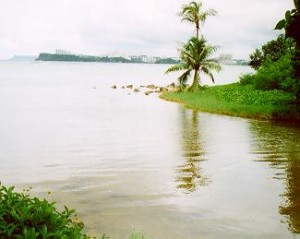 On July 4, 1917, Gov. Roy C. Smith approved the plan, and two days later, the flag was unveiled for the first time at a Hagåtña parade.
On July 4, 1917, Gov. Roy C. Smith approved the plan, and two days later, the flag was unveiled for the first time at a Hagåtña parade.
Taken from the center portion of the Guam Flag, Governor Roy C. Smith approved the design as the “Official Coat of Arms” for the territory of Guam on July 4, 1917. April 4, 1930 was the formal adoption date of the official Seal of the Territory of Guam, under the administration of Governor Willis W. Bradley Jr. who changed it from one with an eagle on it.
The Seal was designed in the city of Agana from a scene where the diverted Agana River formerly empties into the Philippine Sea in a spot to the left or south side of the Navy Yard Reservation. The ‘Landing’ at the end of the present day Hagatna Boat Basin Channel was where the Navy Yard used to be (from interview with Dr. Lawrence Cunningham). Following a disastrous typhoon which left only a coconut tree standing, this setting inspired the design for the official Seal of Guam. The shape of the Seal represents the shape of the slingstone which the ancient Chamoru warriors employ as an implement for defense. That iconic shape cradles and protects the rest of the features within the seal. At the heart of the seal is the coconut growing in the unfertile sand which depicts determination. Although partly uprooted during the recent typhoon, as if in utter defiance to all adversities, this tree with trunk partly bent, turned its open fronds to receive illumination from the heavens and continue its growth.
According to the Organic Act of Guam 1GCA, Chapter 4, Sections 410 and 411, “The Lieutenant Governor of Guam shall have custody of the Great Seal of the territory of Guam,” thus the Lieutenant Governor is the official “keeper” of the Seal.
DESCRIPTION OF THE FLAG’S SYMBOLS: The shape of the seal is that of a Chamorro sling stone used as a weapon for warfare and hunting. The sling stone was quarried from basalt and coral. The Coconut Tree, growing in unfertile sand, symbolizes self-sustanance and determination to grow and survive under any circumstance, with its fronds open to the sky — defies the elements to bend its will. Its bent trunk attests to a people which have been tested by famine, natural calamities, genocide and foreign wars but have continued to endure as a race. The Flying Proa, a seagoing craft built by the Chamorro people, which was fast and agile in the water required great skill to build and sail. The spanish marveled at the grace and speed of the proa which typifies the courage and freedom of the ancient Chamorros to fearlessly navigate and trade with islands thousands of miles from Guam. The original River channel (south side of present day Hagatna Boat Basin Channel), where fresh water rush out to interact with the ocean, symbolizes a willingness to share the resources of the land with others. The permanence of the land mass of Urunao (Ulu Enao) in the background (Rogers, Robert. Destiny’s Landfall. 1995 Univ of Hawaii Press. pg 142) demonstrates the Chamorro’s commitment to their homeland and environment, be it sea or land. The historian Pale Eric Forbes (http://paleric.blogspot.com)has written that the background of the seal is not Puntan Dos Amantes (aka Two lovers point, Cabo de Dos Amantes, Pt Desamante (from William Edwin Safford, Rev. Jose Palomo Y Torres, R.P. Tolman 1904 map)). Father Eric Forbes has stated that one cannot see Two Lover’s Point from Hagatna since Oka Peninsula (near Apurguan) blocks Hagatna’s view of the Two Lover’s Point. The background cliff juts majestically into the endless waters of the sea, protraying the people’s faithful commitment to passing their proud heritage, culture, and language to the endless sea of future generations. GUAM or GUAHAN means “we have” (see *notes below) is the home (“Tano Y Chamoru”) of the Chamoru people. A red stripe surrounding the Guam Seal representing the blood shed by its people during World War II and Spanish occupation. A field of Blue represents Guam’s unity with the sea and sky.
SHARE JIUJITSU: Fernando “Terere” Augusto
May 9, 2016 by admin
Filed under Special Forces
For friends and Family in the United States and whoever else might be a day behind– Happy Mothers Day
Fernando “Terere” Augusto and his beautiful mother in Brazil!
#cultivatethespirit
#itsafamilything
#nevergiveup
—————-
Fernando Augusto, most commonly known by his nickname, “Terere”, is one of the most talented and charismaticBrazilian jiu jitsu fighters to have ever stepped on a mat. This multiple time world medallist became a black belt world champion for the first time at the age of 20 and was regarded as a “Pound for Pound” best during the early 2000’s, he also had great impact as a coach, having helped raise the game of fighters such as André Galvao, Rubens Charles, Michael Langhi, Lucas Lepri, among many others; though a diagnosed case of schizophrenia led him to drug addiction and away from jiu jitsu. He appeared back into the BJJ scene in 2010, but his recovery was erratic and followed with a few ups and downs. Terere returned to jiu jitsu competition in Mexico on September 2012.
Fernando “Tererê” Jiu Jitsu
Full name: Fernando Augusto da Silva
Nickname: Terere is the name of a Brazilian herb used on a famous Brazilian tea. The nickname however was first mentioned by Muzio de Angelis at the Academia Strike where Fernando Terere used to train when he was a blue belt, Fernando loved singing a popular song that had the word “Terere” in the chorus and for that reason the name came up.
Lineage: Mitsuyo Maeda > Carlos Gracie > Helio Gracie > Rolls Gracie > Romero Cavalcanti > Alexandre Paiva > Fernando Augusto Terere
Main Achievements:
- World Champion (black belt: 2000, 2003; brown: 1999, purple: 1998 weight & absolute; blue: 1997)
- World Cup Champion (2002, 2003)
- Brazilian National Champion (2001, 2003 black)
- Pan American Champion (2004)
- World Silver Medallist (2001, 2004 as a super heavyweight*)
- Pan American Silver Medallist (2004 absolute)
* Fought 3 classes above his weight
Weight Division: Peso Medio – Middleweight (82Kg – 181lbs)
ByTheBay VOYAGER – Northern Mariana Island Pagan
May 7, 2016 by admin
Filed under Special Forces
ByTheBay VOYAGER – Northern Mariana Island Pagan
Pagan is a volcanic island in the Mariana Islands archipelago in the Pacific Ocean, belonging to the Commonwealth of the Northern Mariana Islands. Formerly inhabited, the inhabitants were evacuated due to volcanic eruptions in 1981.
Archaeological finds indicate that Pagan was settled from several centuries BC. The first European contact was in 1669, when the island was sighted by the Spanish missionary Diego Luis de San Vitores who named it San Ignacio (Saint Ignatius in Spanish). It is likely that it was previously visited in 1522 by the Spanish sailor Gonzalo de Vigo, deserter from the Magellan expedition in 1521, and was the first European castaway in the history of the Pacific.[2] The native Chamorro population was forcibly deported to Saipan in 1695, and then three years later to Guam. The Chamorros began to return to Pagan in the early 19th century, but found that the island had been colonized by freed Kanakas from the Caroline islands. In the 1870s, first coconut plantations were established.
After the sale of the Northern Mariana islands by Spain to the German Empire in 1899, the island was administered as part of the colony ofGerman New Guinea and leased to a private company, the Pagan Society, which traded mainly copra. The company was a partnership between a German and a Japanese. The island was devastated by typhoons in July and September 1905, September 1907 and in December 1913 which destroyed the coconut plantations and bankrupted the Pagan Society. In 1914, during World War I, the island was captured by the Empire of Japan, which was awarded control by the League of Nations as part of the South Pacific Mandate. The island was settled by ethnic Japanese and Okinawans, who restored the coconut plantations and raised cotton and sweet potatoes for export. In addition, the Japanese developedcommercial fishing for bonito and tuna. On the island were ropes made and to a lesser extent sulfur removed. An airfield was established in 1935, and the Imperial Japanese Navy established a garrison in 1937. In 1942, the Japanese civilian population was 413 persons, with another 229 Chamorro residents. In June 1944, a garrison force of 2150 men of the Imperial Japanese Army arrived,[3] only to be cut off and isolated by the ongoing Allied offensive. Receiving supplies only occasionally by a submarine, the garrison soon faced starvation, and several hundred died of malnutrition before the surrender of Japan.

Landsat view of Pagan
After World War II, under United States occupation, Pagan became part of the UN Trust Territory of the Pacific Islands until the granting of U.S. Commonwealth status. After the war, the United States Navy maintained a small establishment on Pagan and during the 1950s built public institutions, including a church, a copra warehouse, infirmary and a school house. However, the civilian population was under 100 people by the end of the 1970s, many of whom were seasonally present from Saipan. On May 15, 1981, Mount Pagan erupted, with lava flows covering a large part of the island’s arable land and part of the runway. The eruption lasted until 1985; furthermore, small outbreaks came in 1987, 1988, 1992, 1993, 1996, 2006, 2009, 2010 and 2012. The population of the island was evacuated to Saipan in May 1981. Repeated petitions by the islanders to return have been rejected by the authorities due to the continuing threat posed by the volcano. Efforts are underway by the Northern Islands Mayor’s Office and concerned citizens to assist the approximately 300 displaced residents of the Northern Islands who wish to return and resettle in Anatahan, Alamagan, Pagan and Agrigan. Bandara was a settlement in the northwest of the island.
Pagan Island was included during Operation Christmas Drop 2006. United States Air Force C-130aircrew observed cattle and a small cluster of buildings, including a grass airstrip, located on the island. Plans by a Japanese investor group to use Pagan as a dumping ground for debris and rubble from the 2011 T?hoku earthquake and tsunami in Japan were provisionally shelved after protests in June 2012.[4]
Politically, Pagan remains part of the Northern Islands Municipality.
VIDEO: Fight Night Rotterdam: Guam’s Jon Tuck
May 3, 2016 by admin
Filed under Special Forces
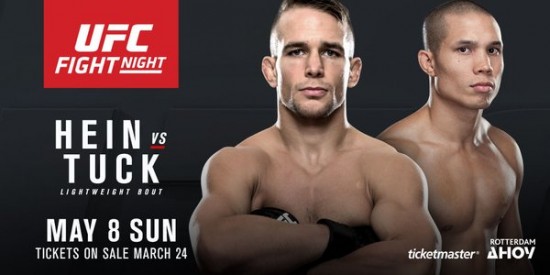
Jon Tuck vs Nick Hein UFC Fight Night
Jon Tuck brings a part of his heritage with him into every fight, giving him strength and the fighting spirit. Catch his upcoming fight against Nick Hein at UFC Fight Night Rotterdam this Sunday.
Tuck finds strength and fighting spirit in the Chamorro heritage and culture. You see his heart and desire to fight in all his UFC bouts. A UFC vet since 2012, tuck will be working his way up the lightweight division with tough prospect ahead of him, Nick Hein.
Here is an awesome video of Jon Tuck showcasing our island in preparation for his fight in Rotterdam.
Para i Onra Tuck!
Island Girl World Achievement:Pia Mia Perez
April 27, 2016 by admin
Filed under FokaiFemme
Incredible, Remarkable, and absolutely Amazing.
At just 21years old, Pia Mia Perez was just had picked by Music Phenom Madonna as Fashion Director of her new fashion label “Material Girl”.
With all the setbacks to excel in Hollywood that might work against a small island girl, Pia Perez (Pia Mia) has overcome all odds to make it to the top of the list from the legendary world pop-star icon.
Here is the link to an interview of Pia with two time Oyompian (and other Guam girl super-achiever) Maria Dunn at the Fokai Femme Shop @13North 144East
Fokai/Guahan Napu collaboration tank by Ed Lacquata
April 24, 2016 by admin
Filed under Special Forces
#justaddwater
Homemade fashion modification to Fokai/Guahan Napu collaboration tank by Ed Lacquata
Ed, “Gonzo” Lacquata had gone from one of Guam’s top surfers to one of Guam’s most extensive surf artists back in the late 80′s. With countless of hand drawn and painted surf art pieces–his trademark artwork included first person perspectives from inside the barrel at right side and left side Boat Basin.
Today, though his art has taken a backseat to family life, jiujitsu, world trsvel, and of course surfing–he still sketches from time to time. Never losing an edge.
#gonzo
#fokaiamphibiousdivision
#sinceeversince
Brandon Vera’s thoughts on Conor McGregor’s dispute with UFC
April 24, 2016 by admin
Filed under Special Forces
By: Brandon “The Truth” Vera
I have been asked a number of times about my thoughts on Conor McGregor’s dispute with the UFC.
First, I understand why many fighters may not like McGregor personally because of his promotional antics and some of the comments he has made about his fellow competitors. It did not sit well with me that Conor didn’t stand by Jose Aldo when the promotion threw him under the bus after Aldo’s injury. I cannot, however, be blinded by past events. The fact is McGregor’s current conflict with the promoter is a struggle we all share. When the dispute is between promoter and fighter—I already know what side I am on—the fighter. I am a fighter.
Conor is approaching perhaps the biggest fight of his career coming off of his first loss. I fully appreciate his desire and need to focus his energy on a successful training camp, and for wanting to limit and schedule his promotional obligations around that camp. Conor is a master promoter as it is—if he wants extra time in camp—how can anyone argue? As professional athletes, first and foremost, our obligation is to prepare and compete at our best. Conor is asking for nothing less, for having a say in the amount and timing of his promotional duties and this is something all fighters should sympathize with. Currently, this issue isn’t just McGregor’s, but all mixed martial artists who have no say in when or how they are promoted, and they receive no additional compensation for extra promotional obligations.
 This is why I support Conor McGregor. This is why I think all fighters should support not just Conor but the MMAFA too. This why we are fighting against one-sided coercive contracts that prevent us from getting our market value. This is why we’re working to get the Ali Act extended to Mixed Martial Arts so we are protected from promoters forcing us to accept every demand they make and are able to enjoy a free market.
This is why I support Conor McGregor. This is why I think all fighters should support not just Conor but the MMAFA too. This why we are fighting against one-sided coercive contracts that prevent us from getting our market value. This is why we’re working to get the Ali Act extended to Mixed Martial Arts so we are protected from promoters forcing us to accept every demand they make and are able to enjoy a free market.
I’m doing this so McGregor and every fighter doesn’t have to put up with this in the future. If McGregor joins us that would be great. It would likely make this happen faster and easier if he did. But even if he doesn’t I’m still going to work for this because i believe every fighter deserves these things.
I look forward to the day a couple years from now when we’ve succeeded, and McGregor is signing the biggest contract in combat sports history. I will know I stood on the line and fought for this to happen, to improve the great sport of MMA and to better the plight of my fellow athletes. We are succeeding—we are already seeing changes. That, in my opinion, is no coincidence.
I hope Conor and every fighter recognizes our mutual interests.
Pena wins Marianas Open, receives $10,000 prize
Pena wins Marianas Open, receives $10,000 prize
Marianas Open defending champion Keenan Cornelius faced off against Felipe Pena in the final of the Absolute Black Belt Championship on April 16 at the Father Duenas Memorial School’s Phoenix Center, losing by a 4-2 decision.
Pena and Cornelius had fought only once before, and that time it was Cornelius who was awarded the win by decision.
Pena was determined not to let the prior loss affect this fight and came out strong, earning two quick points by sweep. Cornelius responded with a sweep of his own, leaving an even fight until the seventh minute. Pena was able to get one last sweep to take control for the final three minutes, and was named the new Marianas Open Champion. Pena was awarded the $10,000 cash prize for first place.
“I’m really happy to be here,” said Pena. “To have gone out there and win, it’s a really good feeling. It was great being in Guam. I love the people, the island and I am looking forward to defending the title next year.”
Marianas Open founder Steve Shimizu was impressed with how competitive all of the fights were, including the championship bout between two of the best fighters in the world. His goal was to send the message that Guam is a place for competitive jiujitsu fighters to come to, and he believes that message was sent.
“It shows that jiujitsu can go any way,” he said.
“You have the reigning champion get dethroned, but they fought hard. It shows that the level is here. Guam is the place for them to come now and they know that we do just as good of a job as anywhere else in the world.”
Cornelius was awarded $3,000, while third-place finisher Igor Schneider was awarded $2,000. Schneider fought against Guam native Terrence Aflague, going up 29-0 and finishing it with a submission by armbar.

PACIFIC DAILY NEWS
Preba Hao “Prove Yourself” features 14 fights
Semifinal
Prior to winning the championship, Pena defeated Aflague in the semifinal bout. Pena was able to rack up seven quick points, passing guard into a mount. From there, Pena wore Aflague down until he was able to get him in a bow and arrow position, leading to a submission.
The other semifinal fight, between Cornelius and Schneider, also led to a bow and arrow submission, though the fight was more evenly matched, with Cornelius landing only two points by sweep prior to the submission.
First round
The first fight of the day was between Pena and Guilherme Augusto Santos. Santos put up a good fight against the future champion and it wasn’t until the final minute that Pena was able to earn two points by sweep and win the fight.
Aflague faced Joel Bouhey for the second fight of the day, winning by a score of 3-0. The fight began slow with the fighters in a 50-50 guard, but Aflague was able to pass guard about six minutes in and earn the three points he would need to advance to the semifinals.
Cornelius faced Jacob Guerrero of Barrigada in the first round of fights. Guerrero stepped up to fight on short notice after Rhalan Gracie withdrew Friday night due to an injured right knee. Unfortunately for Guerrero, he was mismatched against Cornelius and lost by submission after a painful bicep slice.
The third Guam fighter, Bryant Pangelinan, was matched against Schneider for the fourth fight of the day and final of the first round. Schneider was able to control Pangelinan after a sweep into a back mount gave him the position he needed to win the fight by a 6-0 decision.
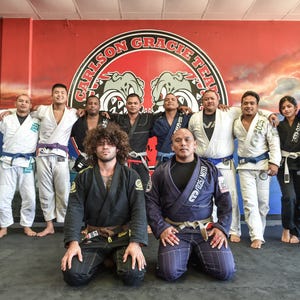
PACIFIC DAILY NEWS
Carbullido wins double gold
Brown belt
Nick Calvanese won the Absolute Brown Belt division — and airfare, hotel accommodations and registration entrance fee into the Pan Asia BJJ tourney in the Philippines in May.
The Voyagers: Ana Varu Rediected
April 18, 2016 by admin
Filed under GuamWatermen'sClub
Mother nature cuts proa voyage short, journey ends in Palau
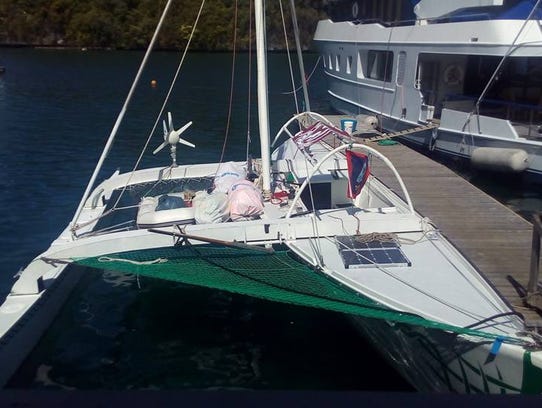
Two men traveling on a Chamorro style proa from Taiwan to Guam had a rough journey at sea, which ended in Palau. Ignacio R. “Nash” Camacho, a local traditional seafarer, and Burghard Pieske, a German sailor, were attempting to make the more than 1,000-mile trip from Taiwan to Guam on the Ana Varu, a boat made with the design of the ancient Chamorro proa. “It was a bad journey. It was not fun. It wasn’t pleasant. Every moment was fighting for survival,” Camacho said. They had to fight constant bad winds, high waves and strong currents, he added. Though their goal was Guam, Pieske said Mother Nature made other plans for them, cutting their journey short in Palau.

PACIFIC DAILY NEWS Brazilian family sailing the world makes stop in Guam
“It was overwhelming. It was fascinating. It was horrible. It was terrible,” Pieske said about the trip. The journey was exhausting, since it was almost impossible to sleep on the rough seas. Both men thanked everyone who helped them get to land safely in Palau. The men were out at sea for more than 15 days. They were warmly greeted in Palau and were well taken care of, Camacho said. The two men landed in Palau on April 4 and flew back to Guam Wednesday. The welcome from all officials, coordinated by the efforts of Palau Community College President Patrick Tellei and so many others, has a lifelong debt of gratitude from Camacho, Pieske and their families, Camacho said.
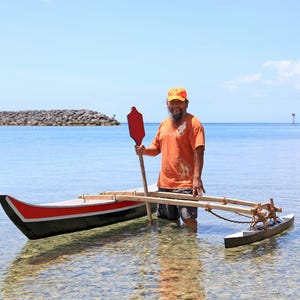
PACIFIC DAILY NEWS Proa to sail from Taiwan to Guam
Although the voyagers weren’t able to complete their journey to Guam, Camacho said the trip was still a success. “We have absolute confidence that our mission is a success. We have highlighted the journeys of our common ancestors’ migration despite not reaching Guam directly,” he said. The men left Taiwan on March 19. The Taiwan government and people were very supportive of the men, Pieske said. In fact, they held a mini festival for them, with lots of dancing and food. The Ana Varu was built of modern materials, but used ancient islander wisdom and design, Pieske said. That was very valuable for the trip, because it was used thousands of years ago though with more natural materials. Camacho said the canoe’s structure made it possible to survive the beating from the sea. But the boat did take some damage and will need to be fixed before it goes back into the water. “It was the perfection of our people that brought us through the worst of storms,” he said. (Story continues below photo.)
Camacho added he was humbled that in this day and age with modern technology, they still struggled to make their way to Guam. He could only imagine what his Chamorro ancestors felt having none of that technology to help in navigating the ocean. “I can’t help but think it doesn’t compare to the accomplishments of our ancestors in their day,” he said. Camacho also said it was sad that this journey comes hundreds of years after the last long voyage on sea because of colonization that stopped seafaring from happening on the islands. The loss of seafaring culture is a tragedy, Camacho said, but he’s hopeful the trip will inspire others to learn and take on seafaring.
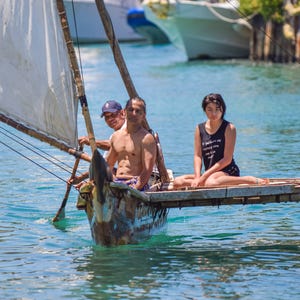
PACIFIC DAILY NEWS FestPac to honor tradition, bravery of ancestor seafarers
“We can still do it. We need to revive it and use it and educate ourselves and inspire ourselves,” he said. Pieske said it was unbelievable and amazing that the ancient islanders were able to make such long journeys on nothing more than natural materials. “After this trip, I admire these ancient seafarers much more than before,” he said.
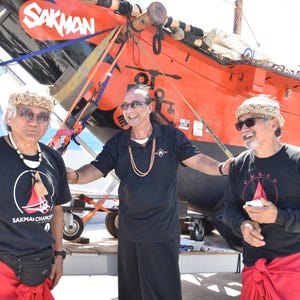
PACIFIC DAILY NEWS Sakman Chamorro arrives in Guam
The Ana Varu will stay in Guam and go through repairs. The seafarers are both excited for all the other islanders who will be here for the Festival of Pacific Arts being hosted on island from May 22 to June 4
Felipe Pena Strollin by the Fokai Shop
April 18, 2016 by admin
Filed under Special Forces
The Force is with Them:
Welcome to Guam all our visiting competitors and Congratulatons to all the competitors and podium takers of the Marianas Open 2016.
Blackbelt Open 2016 Marianas Open Champion Felipe Pena and Lorena with awesome host Tony Q swing by the epicenter for a good vibe and Hafa Adai.
#thefokaishop
#theforce
#sharejiujitsu

